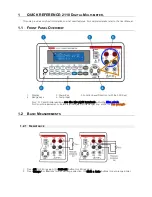
User’s
Manual
Model 732 01/02/03/04
Digital Multimeters
IM 73201E
1st Edition Feb. 1999
3rd Edition July. 2001
Safety Precautions
Various symbols are used on the instrument and thoughout this manual to ensure safe use of the
product and to protect against possible hazards or damage.
The following safety symbols are used where app. opriate.
Read the explanations carefully and familiarize yourself with the symbols before reading the
text.
WARNING
This symbol indicates that misuse of the instrument could result in in-
jury or death of personnel.
CAUTION
This symbol indicates that misuse of the instrument could result in in-
jury of personnel or damage to the instrument.
The instrument and this manual also use the following safety symbols:
Caution
This symbol indicates that the operator must refer to an explanation in the
instruction manual in order to avoid the risk of injury or death of personnel or
damage to the instrument.
Double Insulation
This symbol indicates double insulation.
Alternating current
This symbol indicates AC voltage/current.
Direct current
This symbol indicates DC voltage/current.
Fuse
This symbol indicates a fuse.
Earth TERMINAL
This symbol indicates ground.
WARNING
■
To avoid electric shock!
• Do not use deteriorated or damaged testing leads. Check testing leads before use.
• Do not use the instrument if there is any damage to the casing or when the casing is
removed.
• Disconnect the instrument from the circuit under test before opening the casing to re-
place the batteries or for any other reason.
• Avoid using the instrument if it has been exposed to rain or moisture or if your hands
are wet.
■
To avoid electrical shock or fire!
Do not use the instrument in an atmosphere where any flammable or explosive gas is
present.
WARNING
■
To avoid damage to instrument or electric shock!
The restrictions on the maximum voltage level for which the 732 01, 02, 03 and 04
multimeters can be used, depend on the over-voltage categories specified by the safety
standards. These category specifications are formulated to protect operators against
transient impulse voltages in power lines.
Over-voltage Category (CAT.)
Maximum Input Voltage
II
600 V
III
300 V
Over-voltage category I (CAT. I):
Covers the path from a mains outlet, through a power transformer, to a circuit in the
transformer's secondary stage.
Over-voltage category II (CAT. II):
Covers a primary-stage circuit of equipment connected to a mains outlet.
Over-voltage category III (CAT. III):
Covers the path from an indoor distribution switchboard to a mains outlet.
V
mA
µ
A
A
COM
/
/
4/10
40/400
400/4000
uA
mA
A
V
V
OFF
V
Black testing lead
Red testing lead
Store this manual in a safe place for
future reference.
CAUTION
• Do not use the multimeter near noise-emitting equipment or where there may be a
sudden temperature change. Otherwise, the instrument may produce an unstable read-
ing or errors.
• Do not wipe the instrument using any organic solvent such as benzine or paint thinner.
Otherwise, the front panel may be damaged or discolored. When cleaning the instru-
ment, use a dry cloth.
• Do not leave the multimeter exposed to direct sunlight or in a hot and humid location
such as the inside of a car, for any prolonged length of time.
Components
1) Function Switch
Turns off the power or selects the measurement mode.
OFF:
Turns off the power.
V:
AC voltage measurement
V:
DC voltage measurement
Ω
/
:
Resistance measurement and continuity check (732 02/03)
Ω
:
Resistance measurement (732 01/04)
:
Continuity check (732 01/04)
:
Diode test
:
Capacitor check (732 02/03)
µ
A:
DC/AC current measurement in micro-amperes
mA:
DC/AC current measurement in milli-amperes (732 01/02/03)
A:
DC/AC current measurement in amperes
2) SELECT key (732 02/03) or
/ key (732 01)*
This function is not supported on the 732 04 multimeter.
This key is enabled only if the multimeter is in one of the following measurement modes.
•
Ω
/
:
In this mode, the button selects between the resistance measurement and continu-
ity test.
•
:
In this mode, the button adjusts the stray capacitance of the testing leads and the
multimeter itself to zero.
(The display shows the
CAL
symbol.)
•
µ
A/mA/A: In this mode, the button selects between the DC and AC modes.
* The 732 01 multimeter comes with the
/ key instead of the SELECT key. This key is used
only to select between the DC and AC modes in the current measurement mode.
3) RANGE key * This function is not supported on the 732 04 multimeter.
Allows the operator to select the measuring range manually (the display shows the
R • H
sym-
bol).
To return to the normal auto-ranging mode, hold down this button for at least one second until
the display shows “AUTO.”
4) AUTO-H key
Set up AUTO HOLD function. (the display shows the
A • H
symbol).
<1> Function switch
Input terminal
<5> Display
<4> AUTO.H key
<3> RANGE key
*(2) and (3) are not supported on the 732 04 multimeter.
<2> SELECT key (732 02/03)
or
(
/= key (732 01)
V
mA
µ
A
A
COM
/
/
4/10
40/400
400/4000
uA
mA
A
V
V
OFF
AUTO.H
RANGE
SELECT
DIGITAL
MULTIMETER
5) Display View with All Elements Turned On
A • H
R • H
CAL
+ –
Lit when in DC-mode measurement
Lit when in AC-mode measurement
Polarity indicator lit when the polarity is negative
Lit when in diode test
Lit when in continuity check
AUTO HOLD indicator
Manual range indicator
Auto range indicator
AUTO POWER OFF indicator
Unit for capacitance measurement
Unit for voltage measurement
Unit for current measurement
Unit for resistance measurement
Lit when stray capacitance is adjusted to zero
Lit when the batteries are low
Symbol and Unit
AUTO
AUTO POWER OFF
nF,
µ
F
mV, V
µ
A, mA, A
Ω
,
k
Ω
,
ΜΩ
Description
V
mA
µ
A
A
COM
/
/
4/10
40/400
400/4000
uA
mA
A
V
V
OFF
V
Black testing lead
Red testing lead
Measuring Instructions
CAUTION
To avoid damage to Instrument or equipment.
• Before starting measurement, check to which mode the function switch is set and make
sure the testing leads are plugged into the terminals for the desired mode of measure-
ment.
• Temporarily remove the testing leads from the device under test before operating the
function switch.
• AC Voltage Measurement ( V)
a) Set the function switch from the OFF position to the V position.
b) Plug the black testing lead into the COM input terminal and the red
testing lead into the V•
Ω
•
input terminal.
c) Connect the testing leads to the circuit under test and then read the
multimeter when it stabilizes.
d) When measurement is complete, set the function switch back to the
OFF position and turn off the multimeter.
• DC Voltage Measurement ( V)
a) Set the function switch from the OFF position to the V position.
b) Plug the black testing lead into the COM input terminal and the red
testing lead into the V•
Ω
•
input terminal.
c) Connect the testing leads to the circuit under test and then read the
multimeter when it stabilizes.
d) When measurement is complete, set the function switch back to the
OFF position and turn off the multimeter.
NOTE
Do not mistake the following for a malfunction!
If the 400 mV range is selected and the testing leads are left open-circuited, the multim-
eter may give a certain reading. This does not affect your measurement.
• Resistance Measurement (
Ω
)
CAUTION
To avoid damage to instrument!
Turn off the power to the circuit under test before starting measurement in order to pre-
vent any excessive voltage from being applied to the multimeter.
a) Place the function switch in the
Ω
position (732 01/04) or
Ω
/
position (732 02/03).
b) Plug the black testing lead into the COM input terminal and the red
testing lead into the V•
Ω
•
input terminal.
c) Connect the testing leads to the circuit under test and then read the
multimeter when it stabilizes.
d) When measurement is complete, place the function switch in the
OFF position and turn off the multimeter.
• Continuity Check (
)
CAUTION
To avoid damage to instrument!
Turn off the power to the circuit under test before starting measurement in order to pre-
vent any excessive voltage from being applied to the multimeter.
a) If the model is 732 01 or 04, place the function switch in the
position.
If the model is 732 02 or 03, place the function switch in the
Ω
/
position, and then press the SELECT key. (The
symbol appears
on the display.)
b) Plug the black testing lead into the COM input terminal and the red
testing lead into the V•
Ω
•
input terminal.
c) Connect the testing leads to the circuit under check. If the circuit is
continuous (no more than approximately 50
Ω
), the buzzer sounds.
d) When the test is complete, place the function switch in the OFF
position and turn off the multimeter.
V
mA
µ
A
A
COM
/
/
4/10
40/400
400/4000
uA
mA
A
V
V
OFF
Black testing lead
Red testing lead
V
mA
µ
A
A
COM
/
/
4/10
40/400
400/4000
uA
mA
A
V
V
OFF
Black testing lead
Red testing lead
KIM3E-2002.7
YOKOGAWA M&C CORPORATION
International Sales Dept.
2-9-32 Nakacho, Musashino-shi, Tokyo, 180-8750 Japan
Phone: 81-422-52-5716 Facsimile: 81-422-55-8954
YOKOGAWA CORPORATION OF AMERICA (U.S.A.)
Phone: 1-770-253-7000 Facsimile: 1-770-251-2088
YOKOGAWA EUROPE B. V. (THE NETHERLANDS)
Phone: 31-334-64-1611 Facsimile: 31-334-64-1610
YOKOGAWA AMERICA DO SUL S. A. (BRAZIL)
Phone: 55-11-5681-2400 Facsimile: 55-11-5681-1274
YOKOGAWA ENGINEERING ASIA PTE. LTD. (SINGAPORE)
Phone: 65-6241-9933 Facsimile: 65-6241-2606
YOKOGAWA MEASURING INSTRUMENTS KOREA CORPORATION (KOREA)
Phone: 82-2-551-0660 to -0664 Facsimile: 82-2-551-0665
YOKOGAWA AUSTRALIA PTY. LTD. (AUSTRALIA)
Phone: 61-2-9805-0699 Facsimile: 61-2-9888-1844
YOKOGAWA BLUE STAR LTD. (INDIA)
Phone: 91-80-227-1513 Facsimile: 91-80-227-4270
LTD. YOKOGAWA ELECTRIC (RUSSIAN FEDERATION)
Phone: 7-095-737-7868 Facsimile: 7-095-737-7869




















